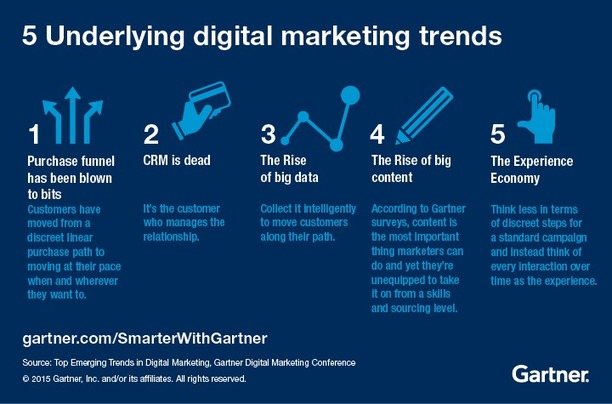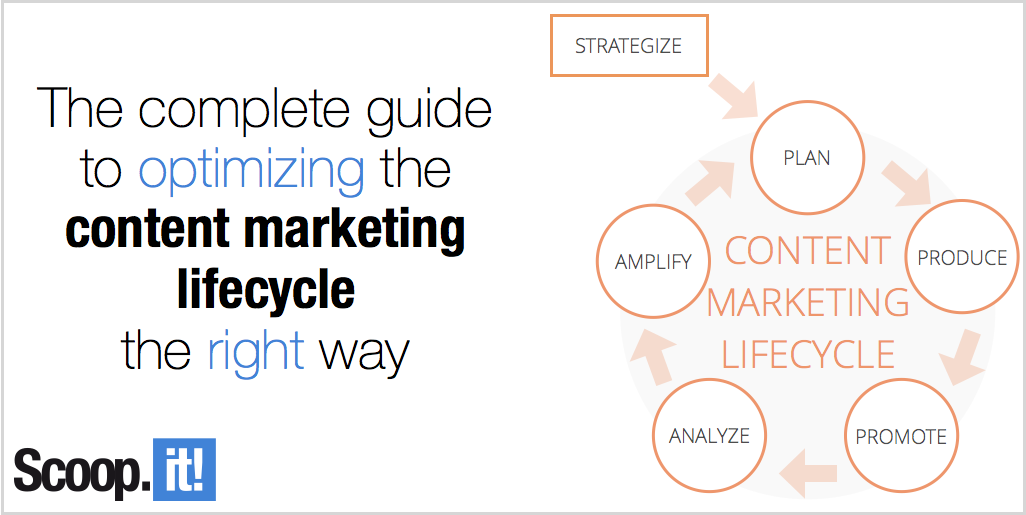
Content marketing is a practice that has been on a steady upswing since 2015. It’s a hot subject amongst top influencers in the marketing space, and even Gartner can’t stress how important it is:
There’s no denying it: content is the most important tool marketers can use, yet most are ill-prepared and lack the skills and resources to take it on.
Because of department divisions across content creation, content optimization, content promotion and analytics, most marketers end up working on only a part of the content marketing lifecycle, or mistakenly assume that just creating good content is sufficient. Content creation is challenging, and it is the first step most content marketing programs have a hard time getting past.
Simply creating good content while neglecting the other stages of the content marketing lifecycle won’t get you anything besides plummeting results.
So what exactly is the content marketing lifecycle? To quote Napoléon, “A good sketch is better than a long speech”:
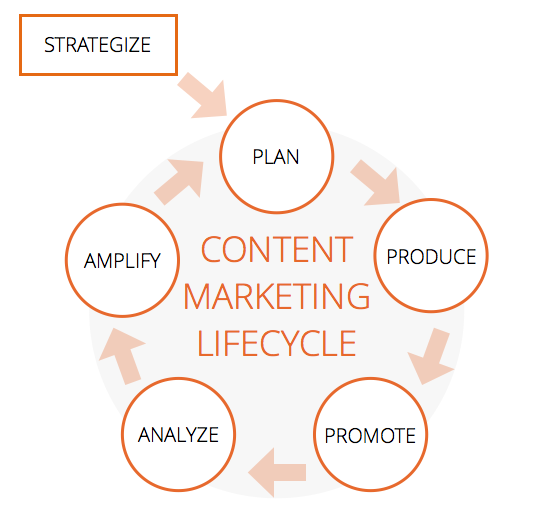
What does the content marketing lifecycle do for you? It indicates exactly where and how much fuel you should put into your content marketing machine in order to take you down the path to positive ROI.
The case for content marketing lifecycle optimization
This matters for a simple reason: 27 million pieces of content are shared every day. That’s not exactly a modest number. And while this means that there’s a lot of crappy content out there muddying up the digital content waters, there’s also a fair amount of good content, which you will inevitably be competing with. This means that if you want your great piece to stand out, you’re going to have to take things a step further. Hence the need for a broader view of the content marketing lifecycle, and this article to help guide you through each step.
1. Strategize your content marketing
This phase is the one you’ll need to recreate the least, nevertheless it’s one of the most important ones and should be revised annually to ensure your content strategy stays aligned with your business objectives.
Why does it matter so much? To put it bluntly, excluding this phase almost guarantees that you set yourself up for failure. Simply because talking is great, but if you don’t talk about what your buyers want you to talk about, then it’s not very useful…
Here are the steps to help you strategize your content marketing:
- Align your business objectives with your expected content marketing results – and define KPIs to monitor the progress!
- Know who your audience is – identify your buyer personas.
- List out the questions each of your buyer personas has about your domain. You need to be able to respond to these – if you have nothing to say that would help them resolve this question or add value, then it’s not a good topic to discuss.
- For each question listed, determine which step of your sales funnel it corresponds: questions about the price of a software like yours is bottom of the funnel while a basic definition of a term or about the domain you are in is more top of the funnel.
- Organize your content framework to convert: each piece of content you publish (whether it’s original, curated, repurposed content) should be optimized for conversion. Always have CTAs on your blog posts to drive traffic to your landing pages and gather more leads.
- Conduct an in-depth content audit regularly (we do one every quarter). This step is unnecessary if you are just starting out with content marketing. But as you get more comfortable and are better able to produce more content, you should make a point to analyze its performance: how many views each piece generated, how many leads you received from it, how many of those leads were qualified / generated deals = $. Not only that, but also what conversion rate did the post get (leads / views), etc. This will help you optimize, update, repurpose and recycle your content over time. Vital practices if you want to save time and produce more quality content!
2. Plan ahead
What you shouldn’t do is plan to write one good piece per month. As we show in multiple reports and studies, publishing more content (blog posts, newsletters, curated content, etc.) has a significant impact on your traffic, shares, leads and revenue. And if you don’t believe me, there’s this:

According to The Sales Lion founder Marcus Sheridan:
“Some ‘just ok’ content that is published will crush ‘awesome content’ that never gets published. You have to produce average content to learn how to produce great content.”
Now you know you need to produce more content. And the more content you produce, the more complex your planning and organization processes inevitably become, and things can get difficult to manage. Which is why you need a content marketing calendar, the solution that saved us when we first decided to increase the frequency of our blog posts from 2 to 4 articles a week.
To plan your content marketing right, you need to do a few things:
- Define your weekly blog publishing goals
- Define your publishing goals per social media channel
- Do the same for your employee advocates
- Make sure the content you produce stays aligned with the goals you set out to accomplish from the beginning
3. Produce content at scale
Here comes the fun part!
Check out this article for guidance on how to produce great content for your blog (and how to do it more consistently). And for additional tips on how to write good blog posts, this piece tackles the subject pretty thoroughly.
When writing, keep in mind that quantity is important in addition to quality.
And if for you too, days don’t seem to stretch more than 24 hours long and your boss doesn’t understand you need more resources to double the amount of posts you produce per month, then you should keep reading. Here are 3 of the most effective techniques for being lean and producing content at scale:
Leverage content curation in your mix
Content curation is the most effective lean content marketing strategy that exists today.
 |
“Content curation not only alleviates the pressure of having to devote valuable time to creating original content, but it also adds credibility and third party validations to your efforts.”
Jason Miller – Senior Content Marketing Leader, Linkedin. |
The benefits are numerous and we have created and curated thousands of articles on the topic. Here are a few of our top selections:
- 10 content curation pros to convince you to start curating now
- Why content curation should be a daily habit for all marketers
- The differences between curated content and duplicate content
- The 7 attributes of highly effective curated posts
Repurpose content
Repurposing is a key strategy for producing more content without adding or exhausting resources. Megan Marrs offers 11 interesting best practices and ideas for how to repurpose content efficiently in this great post. Here is our interpretation:
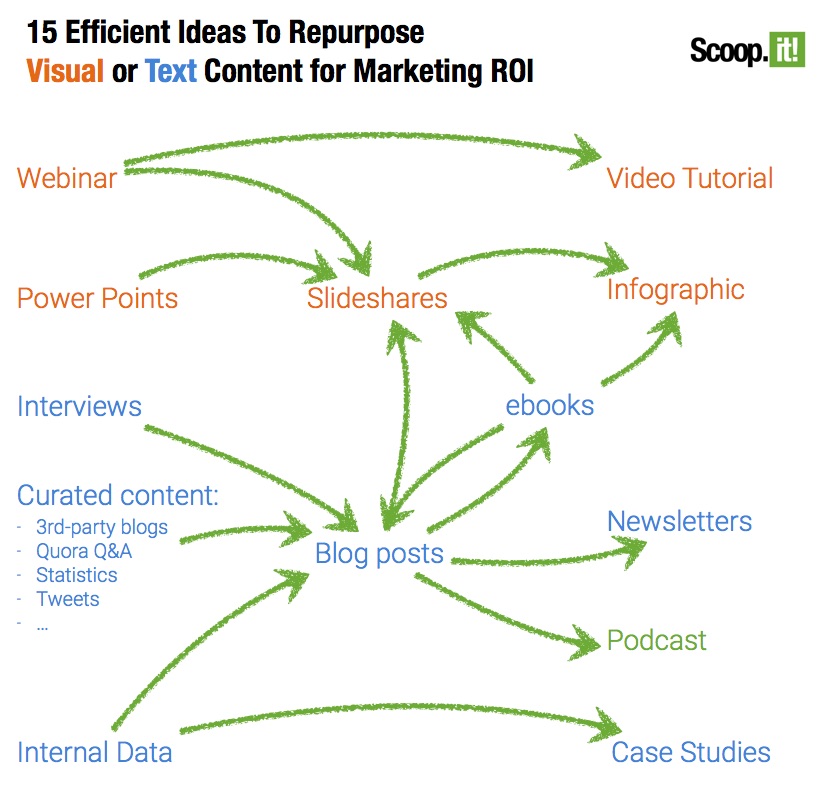
You can check out this article for additional research and insight from influencers for a deeper understanding of repurposing.
Get influencers, co-workers and contributors involved in your content production
Involving others in your content production efforts helps you to not only produce more content but also serves to validate your message, grow and amplify your reach.
Here are tips to help you leverage contributors to grow your content reach.
 |
“Co-creating useful content with your community incentives participation, engagement and promotion. Influencers get exposure and you’ll get relevant content they’re inspired to share.” Lee Odden – CEO, TopRank Online Marketing. |
Want more lean content marketing techniques and best practices? Check out this article.
4. Promote
Want to get your content seen, read and shared? Then you’re going to have to promote it regularly over time. Creating great content is important, but it’s not enough to succeed on its own. Even the most brilliant pieces of content are useless and inefficient without proper promotion to ensure it reaches the audience it was intended for. Here is a simple yet effective guide to help you promote your content in 2016.
Get your co-workers to share your content
Having trouble to get your co-workers to share your content? Here are 3 hacks to get over this issue.
Distribute your content via email
This may seem evident, but you might be surprised by the following data:
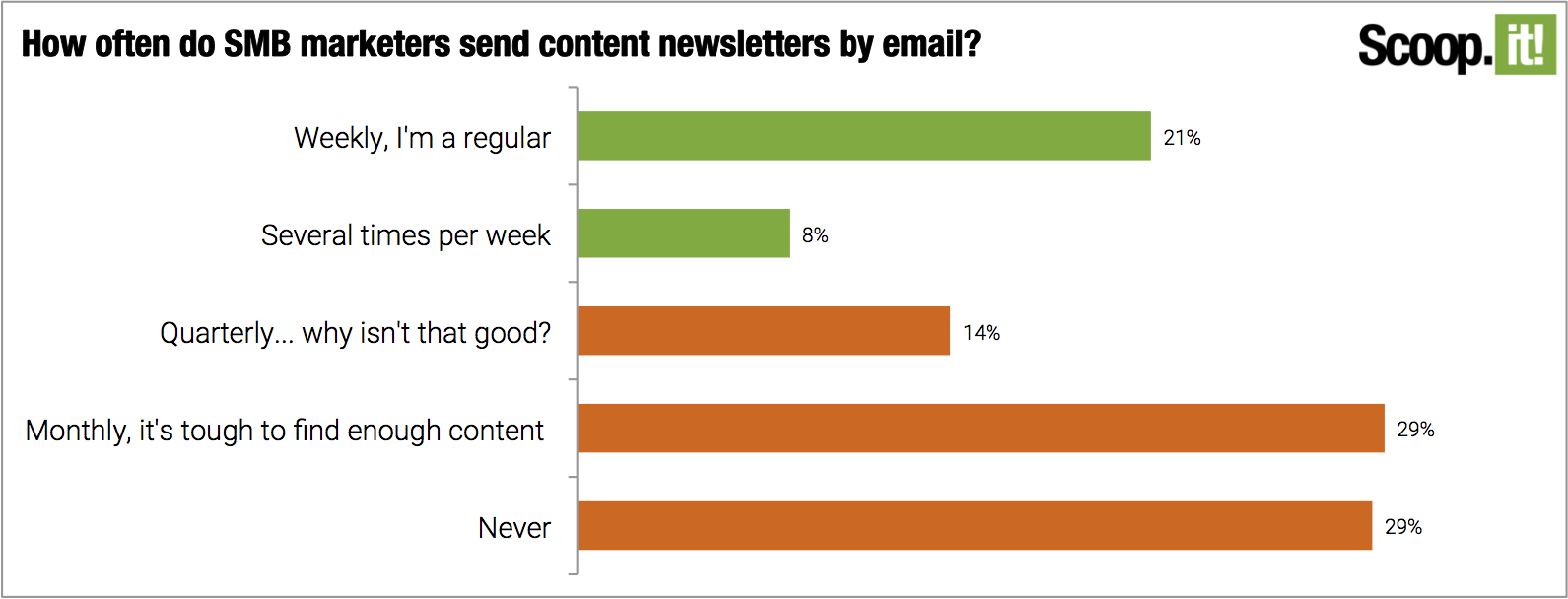
71% marketers send less than one newsletter per week, and 30% never send newsletters at all!
When we increased our email frequency from 2-4 newsletters a month, the results were apparent: increasing the frequency increased the number of recipients we reached through the roof by a factor of 2.5x.
Yes, creating email newsletters takes some time. But if it takes you more than 10-20 minutes, it means you could start saving time today!
Our take on email newsletters: send a weekly round-up mixing original and curated content. Avoid self-promotion, increase frequency.
5. Analyze
You wouldn’t pay $10 a month for Spotify if it offered you only 5% of the songs you wanted to listen to, right? That wouldn’t make sense. How about if you paid for the first month and realized this after? Would you continue paying for the service then?
The same goes for most things. At some point in the process – whether it’s before or after the actual investment was made (be it time, money, efforts, etc.) – you decide based on analyzing the results whether or not the investment was worth it. This is called ROI.
Yet, over 50% of marketers are still unclear on this basic metric. Which begs the question: is your content marketing effective? In order to understand how your efforts are paying off and impacting your ROI, you need to analyze your content.
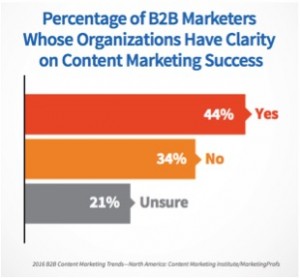
Allow us to interject for a hot second with this handy content marketing model:

– Volume: the number of individual pieces of content that exist on your destination sites and by channels on a daily, weekly or monthly basis. Because content marketing has compounding returns that build over time, it’s essential to leverage your team and curate regularly to sustain your content efforts.
– Shares and traffic: the total number of times your content was shared and the traffic it generated. This measures the quality and the impact of your content on your audience and can be tracked as a time-based chart or post by post:
– Leads your content generated. Ultimately, you want your content to convert your visitors into subscribers, prospects or customers. This can be easily tracked in a time-based chart or post by post using Scoop.it Content Director (check our free content marketing analytics framework to understand why this is important and how to take data-driven actions on your content strategy).
6. Amplify your content marketing efforts
Your efforts should focus on amplifying the content you’ve previously identified as being the most valuable.
Just as you have many techniques to help you produce content, there are several ways to amplify your content marketing efforts.
Influencer marketing
Identify the major influencers in your space who share similar content. Tools like BuzzSumo, BuzzStream or NinjaOutreach can help you to find the right people.
Build relationships: think “IRM” = CRM for influencers
An effective way to attract the attention of influencers is to mention them in your content, or to write about a topic you know is of particular interest to them. Your outreach emails will additionally work best if you have a pre-existing relationship with the influencers that you work actively to build.
 |
“At my agency, we’ve set up multiple shares on all of our content for a long time now, and we almost always find that we get much more lifetime traffic for the content.” Mark Traphagen – Sr Director of Online Marketing, Stone Temple |
Leverage automation for added insight on what to re-share when
Imagine if radio stations had played Michael Jackson’s Billie Jean only once: would it have still become the 80’s biggest hit? Probably not. The same analogy can be made with your content. If you want it to stand out among the others and go down in the rockstar hall of content fame, you have to share it on a regular basis with your audience.
And yet, the data has spoken: Over 65% of markers do not re-share successful posts on a regular basis.

If you want to start amplifying your posts, you have two options:
– manually share recent or evergreen blog posts across your social media channels on a regular basis
– use a tool to help you easily identify the evergreen pieces of content, choose the ones to re-share and automate the scheduling of your social media messages in advance.
Work smarter with content marketing intelligence
While basic marketing automation technology helps you work faster and more efficiently throughout the stages of the content marketing lifecycle, content marketing intelligence helps you improve by finding actionable opportunities for you that you can leverage in just a few clicks, helping you work smarter, not just faster. By leveraging technology and intelligence, you can optimize your efforts in every phase to ensure you reach your goals and deadlines.
If you’re still hungry for more, we just released a new eBook packed full of even more tips to help you optimize the full content marketing lifecycle.
Questions? Comments? Successful practices you’d like to share with us? Feel free to add your comments below. We’d love to hear your thoughts!

